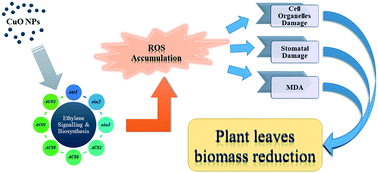当前位置:
X-MOL 学术
›
Environ. Sci.: Nano
›
论文详情
Our official English website, www.x-mol.net, welcomes your
feedback! (Note: you will need to create a separate account there.)
Ethylene mediates CuO NP-induced ultrastructural changes and oxidative stress in Arabidopsis thaliana leaves
Environmental Science: Nano ( IF 5.8 ) Pub Date : 2020/01/03 , DOI: 10.1039/c9en01302d Wardah Azhar 1, 2, 3, 4, 5 , Ali Raza Khan 1, 2, 3, 4, 5 , Noor Muhammad 6, 7, 8 , Bohan Liu 1, 2, 3, 4, 5 , Ge Song 1, 2, 3, 4, 5 , Akhlaq Hussain 4, 9, 10, 11 , Muhammad Umair Yasin 1, 2, 3, 4, 5 , Sulaiman Khan 1, 2, 3, 4, 5 , Raheel Munir 1, 2, 3, 4, 5 , Yinbo Gan 1, 2, 3, 4, 5
Environmental Science: Nano ( IF 5.8 ) Pub Date : 2020/01/03 , DOI: 10.1039/c9en01302d Wardah Azhar 1, 2, 3, 4, 5 , Ali Raza Khan 1, 2, 3, 4, 5 , Noor Muhammad 6, 7, 8 , Bohan Liu 1, 2, 3, 4, 5 , Ge Song 1, 2, 3, 4, 5 , Akhlaq Hussain 4, 9, 10, 11 , Muhammad Umair Yasin 1, 2, 3, 4, 5 , Sulaiman Khan 1, 2, 3, 4, 5 , Raheel Munir 1, 2, 3, 4, 5 , Yinbo Gan 1, 2, 3, 4, 5
Affiliation

|
Metallic oxide nanoparticles (NPs) have received great importance due to their unique properties and valuable applications in various fields. The release of nanoparticles into the environment at a large scale has become a serious threat to the ecosystem especially plants. Various reports have illustrated the toxicity of CuO NPs to plants, but the hypothesis underlying ethylene-mediated CuO NP toxicity is still unknown. The present study was conducted to investigate the response of ethylene-insensitive mutants (ein2-1, ein4 and etr1-3) and WT under CuO NP exposure. The results of the present study showed that CuO NPs adversely affected the biomass, chlorophyll contents, guard cells, stomatal aperture and other cell organelles, with consequent decline in plant biomass. Moreover, CuO NPs significantly increased ROS accumulation and induced toxicity in the leaves of all four genotypes. However, ethylene-insensitive mutants markedly showed less sensitivity to this damage as compared to WT seedlings. More importantly, higher levels of CuO NPs significantly increased the activity of ethylene reporter EBS::GUS lines and the transcript level of ethylene signaling and biosynthesis genes. Furthermore, the expression levels of antioxidant enzyme related-genes were slightly enhanced by the exogenous application of ethylene biosynthesis and perception antagonists cobalt (Co2+) and silver (Ag+), respectively, than the treatment with CuO NP stress alone. In contrast, it is significantly suppressed by an ethylene biosynthesis precursor (ACC), which further provided evidence that ethylene participates in CuO NP-induced oxidative damage and growth reduction in Arabidopsis thaliana leaves.
中文翻译:

乙烯介导CuO NP诱导拟南芥叶片超微结构变化和氧化应激
金属氧化物纳米颗粒(NPs)由于其独特的性能和在各个领域的宝贵应用而受到了极大的重视。纳米颗粒大规模释放到环境中已成为对生态系统特别是植物的严重威胁。各种报道已经阐明了CuO NPs对植物的毒性,但是基于乙烯介导的CuO NP毒性的假说仍然未知。进行本研究以调查对乙烯不敏感的突变体(ein2-1,ein4和etr1-3)和WT在CuO NP暴露下。本研究结果表明,CuO NPs对生物量,叶绿素含量,保卫细胞,气孔孔径和其他细胞器产生不利影响,从而导致植物生物量下降。而且,CuO NPs显着增加了所有四种基因型叶片中的ROS积累并诱导了毒性。然而,与野生苗相比,对乙烯不敏感的突变体对这种损害的敏感性显着降低。更重要的是,较高含量的CuO NPs显着提高了乙烯报告分子EBS :: GUS的活性线和乙烯信号和生物合成基因的转录水平。此外,与单独使用CuO NP胁迫相比,外源应用乙烯生物合成和感知拮抗剂钴(Co 2+)和银(Ag +)分别略微提高了抗氧化酶相关基因的表达水平。相反,它被乙烯生物合成前体(ACC)显着抑制,进一步证明了乙烯参与拟南芥叶片中CuO NP诱导的氧化损伤和生长减少。
更新日期:2020-03-21
中文翻译:

乙烯介导CuO NP诱导拟南芥叶片超微结构变化和氧化应激
金属氧化物纳米颗粒(NPs)由于其独特的性能和在各个领域的宝贵应用而受到了极大的重视。纳米颗粒大规模释放到环境中已成为对生态系统特别是植物的严重威胁。各种报道已经阐明了CuO NPs对植物的毒性,但是基于乙烯介导的CuO NP毒性的假说仍然未知。进行本研究以调查对乙烯不敏感的突变体(ein2-1,ein4和etr1-3)和WT在CuO NP暴露下。本研究结果表明,CuO NPs对生物量,叶绿素含量,保卫细胞,气孔孔径和其他细胞器产生不利影响,从而导致植物生物量下降。而且,CuO NPs显着增加了所有四种基因型叶片中的ROS积累并诱导了毒性。然而,与野生苗相比,对乙烯不敏感的突变体对这种损害的敏感性显着降低。更重要的是,较高含量的CuO NPs显着提高了乙烯报告分子EBS :: GUS的活性线和乙烯信号和生物合成基因的转录水平。此外,与单独使用CuO NP胁迫相比,外源应用乙烯生物合成和感知拮抗剂钴(Co 2+)和银(Ag +)分别略微提高了抗氧化酶相关基因的表达水平。相反,它被乙烯生物合成前体(ACC)显着抑制,进一步证明了乙烯参与拟南芥叶片中CuO NP诱导的氧化损伤和生长减少。











































 京公网安备 11010802027423号
京公网安备 11010802027423号